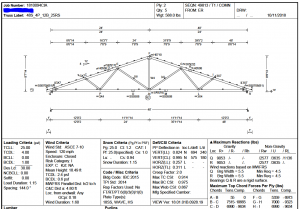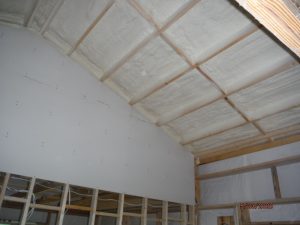This Monday the Pole Barn Guru answers reader questions about engineer stamped plans, hanging sheetrock of OSB from truss bottom chords, and the best choice for spray foam insulation in a post frame building.
DEAR POLE BARN GURU: Are your drawings engineer stamped to meet local municipality requirements? ERIK in LAS VEGAS
 DEAR ERIK: Yes, our structural plans, sealed by our independent third-party engineers are designed to meet or exceed loading requirements for each individual building’s jurisdiction. We have provided several buildings in Clark County, including the giraffe barn at your Lion Habitat Ranch in Henderson. We do always have our clients verify load conditions with their Building Department prior to ordering. This will give you an idea of what will be on form to be completed: https://www.hansenpolebuildings.com/2020/08/building-department-checklist-part-i/.
DEAR ERIK: Yes, our structural plans, sealed by our independent third-party engineers are designed to meet or exceed loading requirements for each individual building’s jurisdiction. We have provided several buildings in Clark County, including the giraffe barn at your Lion Habitat Ranch in Henderson. We do always have our clients verify load conditions with their Building Department prior to ordering. This will give you an idea of what will be on form to be completed: https://www.hansenpolebuildings.com/2020/08/building-department-checklist-part-i/.
DEAR POLE BARN GURU: Can I hang 7/16″ osb or 5/8″ sheetrock from my pole barn style garage with 4′ on center trusses with a 2×4 bottom chord & 2×6 top chord & a 28′ span? I have thought of running 2×4’s perpendicular to the trusses but am concerned about all the weight. Any thoughts or ideas for me? DAVID in HELENA
 DEAR DAVID: If your building’s roof trusses have been designed for at least a five psf (pounds per square foot) bottom chord load (often shown as BCDL on engineered truss drawings) then they could support weight of either 7/16″ OSB or 5/8″ sheetrock. Neither product is designed to span greater than two feet, so you would have to add framing between trusses to adequately support.
DEAR DAVID: If your building’s roof trusses have been designed for at least a five psf (pounds per square foot) bottom chord load (often shown as BCDL on engineered truss drawings) then they could support weight of either 7/16″ OSB or 5/8″ sheetrock. Neither product is designed to span greater than two feet, so you would have to add framing between trusses to adequately support.
This circumstance is why all Hansen Pole Buildings prefabricated wood roof trusses spanning 40 feet or less are designed with a minimum BCDL of five psf or more – just an added service for our clients who decide to add a ceiling later on.
DEAR POLE BARN GURU: I have read many, many of your replies pertaining to the multitude of insulation questions to try and find a scientific and experience answer to an insulation quandary my daughter will experience in a matter of days. I am very familiar with & proficient in stick build & the associated vapor & breathing issues in that form of home building. However, the post & frame discipline is different & yet has some similarities in physics. My daughter & son-in-law are already in contact to have 4″-5″ of “open-cell” spray foam for insulation for walls & roof. I completely understand house wrap, condensation etc….my question is this. Should Tyvek be used between the metal sheathing (siding) & the open- cell or not? The trusses are spaced 2ft o.c. & 2×4 purlins are laid flat 2ft. o.c. then standard girt spacing, etc. on walls. I just want to make sure I provide my daughter with the correct answer so as her family can live in their home with the concern. I thank you for your time and expertise. NICK in MORRIS
DEAR NICK: Luckily physics remains same from stick built to post frame!
 For walls – my preference would be two inches of closed cell sprayed directly to wall steel, then fill balance of wall cavity with unfaced insulation of your choice. Fiberglass would be least expensive for this, although open cell spray foam or BIBs are options (I have done BIBs personally and think it is great).
For walls – my preference would be two inches of closed cell sprayed directly to wall steel, then fill balance of wall cavity with unfaced insulation of your choice. Fiberglass would be least expensive for this, although open cell spray foam or BIBs are options (I have done BIBs personally and think it is great).
For roof – if attic space is to be conditioned and there is no other provision for condensation control, I would start with two inches of closed cell directly to roof steel and then open cell to it to desired R value. If attic space is to be ventilated and insulation placed at ceiling level, if no condensation control do closed cell again, then blow in insulation at ceiling level. This will require adequate eave and ridge ventilation.






